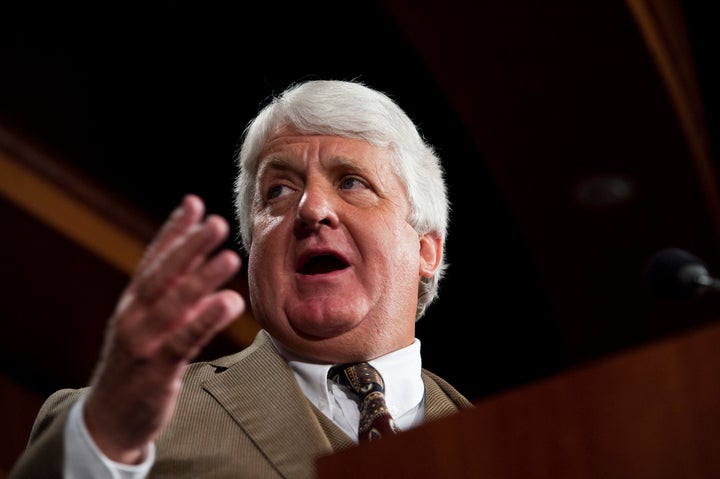WASHINGTON — As Earth stares down the barrel of a sixth mass extinction event, conservative lawmakers in Washington have taken aim not at climate change or habitat loss, but at one of the most important laws meant to protect imperiled species and combat the biodiversity crisis: the Endangered Species Act.
This Republican-led effort was on full display Wednesday when the House Committee on Natural Resources took up five bills targeting portions of the ESA, a 1973 law intended to safeguard threatened species and the habitats critical to their survival.
At the hearing, the U.S. Fish and Wildlife Service voiced support for the package of reform bills. The proposals, agency Acting Director Greg Sheehan said in testimony, “seek to improve implementation of the ESA, and in general the administration supports them.”
Sheehan called the ESA “one of our nation’s important conservation laws,” and said it has had both successes and challenges. “My goal as acting director of the service is for the organization to be a better neighbor and partner to the public and states,” he said.
Among other things, the bills would require that federal agencies consider the economic effects before granting protection for a species, eliminate ESA protections for nonnative species and mandate that agencies supply affected states with all the data they plan to use in determining whether to list a species as endangered or threatened.
In his opening remarks, Rep. Rob Bishop (R-Utah), chairman of the committee, argued that while the ESA was set up to protect and recover threatened species, it has been “misused to try and control land” and “block a host of economic activities, like jobs and energy and infrastructure,” and that it has “proliferated costly litigation which is actually taking taxpayers’ resources away from actual conservation.”
“In short, the ESA doesn’t work,” Bishop said. “We have to find a way to reform it so it actually solves problems.”
Rep. Raúl Grijalva (D-Ariz.), the committee’s ranking Democratic member, argued that the ESA works fine, despite efforts by congressional Republicans to undermine it. He described the legislation up for review as a “weird menu of bills” and an “embarrassment and a waste of time” that would only contribute to extinction.
“ESA does not need congressional meddling to work better,” Grijalva said. “What it needs is congressional support.”

The ESA was enacted with strong bipartisan support and has an impressive record of bringing species like the bald eagle and the humpback whale back from the brink of extinction. Today it provides protections for more than 1,600 plants and animals. But Republicans have been pursuing efforts to undermine the law for years, and now with President Donald Trump in the White House and the GOP in control of both chambers of Congress, the threat seems very real for ESA advocates.
Jamie Rappaport Clark, president and chief executive officer of the conservation nonprofit Defenders of Wildlife and a former director of the U.S. Fish and Wildlife Service, said the “hodgepodge” of bills is “aimed at undermining, circumventing or eliminating” protections under the 43-year-old law.
“None of it is based in science. None of it is going to make the Endangered Species Act work more efficiently or effectively,” Clark told HuffPost on Tuesday. “And absolutely none of what they are doing will accelerate species recovery or slow down species extinction. So it’s really kind of selfish and self-serving.”
“Species are in the way of their special interests,” she added.
In December, shortly after Trump’s surprise victory, Bishop told E&E News that it may be time for lawmakers to “start over again” and “repeal it and replace” the act. Less than a month after Trump took office, the Senate Committee on Environment and Public Works held a hearing called “Oversight: Modernization of the Endangered Species Act.” In his opening remarks, committee chairman John Barrasso (R-Wyo.) — who has sponsored several bills targeting the ESA — said the law “isn’t working today” and “we should all be concerned.”
In an effort to make his point, Barrasso noted that of the 1,652 U.S. species listed as either threatened or endangered at that time, only 47 ― or 2.8 percent ― have been delisted because of their recovery. “As a doctor, if I admit 100 patients to the hospital and only three recover enough under my treatment to be discharged, I would deserve to lose my medical license,” he said.
But Barrasso’s argument ignores the law’s success in preventing 99 percent of listed species from going extinct ― and also glosses over the dire situation facing flora and fauna around the globe. (Over the last few centuries, humans have sped up the extinction rate roughly 1,000 times, according to a 2005 assessment.)
At Wednesday’s hearing, Sheehan and at least two lawmakers used medical metaphors to discuss the ESA.
“I find it helpful to think of the ESA as a hospital, where critically ill patients are admitted in anticipation of recovery,” Sheehan said. “In this hospital, there has been success in keeping the ESA patients from dying, but not so much on getting them discharged in healthy condition.”
“The ESA hospital was never intended to keep all patients indefinitely,” he added.
Rep. Jared Huffman (D-Calif.) said that if an emergency room doctor managed to save 99 percent of critically ill patients, they “would receive universal praise.”
“So I think it’s worth asking why the ESA receives so much criticism in this committee,” Huffman said. “I suspect the answer is pretty simple: The law requires federal agencies to use the best available science to make decisions to prevent extinction, regardless of who produces that science. And that can be bad news for mining companies, for the oil and gas industry, for big developers and others.”
Grijalva likened the ESA to Medicaid, which he said provides health care “to the most vulnerable among us.”

Lawmakers introduced at least 130 separate bills and amendments in the last session of Congress to try to weaken the law ― the vast majority from Republicans, according to a list compiled by Defenders of Wildlife. So far this year, there have been at least 29 measures the nonprofit has identified as anti-ESA, nearly all of them from Republicans.
One of the bills discussed Wednesday would amend the Endangered Species Act to require that the Fish and Wildlife Service and National Marine Fisheries Service, the two agencies that administer the law, review the economic effects of listing a species before making a determination about whether it should receive protection. It would also allow agencies to prioritize petitions for adding or removing species to the ESA and remove deadlines by which those agencies must review petitions.
Rep. Pete Olson (R-Texas), the bill’s sponsor, said Wednesday that arbitrary deadlines don’t help conserve species and that his proposal would amend the law in a way that better protects imperiled wildlife and local communities.
In his written testimony, Sheehan said USFWS wants to “work with the Committee regarding the bill’s proposed warranted but precluded determination on petitions for threatened listings to better understand how economic impacts should be appropriately considered.”
A bill introduced by Rep. Louie Gohmert (R-Texas) would remove nonnative species from protection under the ESA. In a hearing memo, the committee’s Republican majority said the move is about better conserving nonnative species by promoting captive breeding and making it easier to move live animals around the country.
A third proposal, introduced by Rep. Dan Newhouse (R-Wash.), would require that, before determining whether a species will be listed under the ESA, the appropriate agency provide all data used in its analysis to the affected states. It would also mandate that, as part of their analyses, the agencies use data submitted by state, tribal or county governments. While its Republican backers say the bill is about ensuring “decisional transparency,” critics argue it could weaken the listing process by opening the door to “contradictory, out-of-date or fraudulent” data.
The Center for Biological Diversity said in a news release Tuesday that the proposals “are likely the foundation of [Bishop’s] effort to begin dismantling” the environmental law. “If these dangerous bills are enacted, hundreds of plants and animals will be put on a fast track to extinction,” said Brett Hartl, the conservation nonprofit’s government affairs director.
Meanwhile, Trump and his team have left conservationists feeling discomfited about the future of species protections in the U.S. The president’s 2018 budget request calls for slashing the Interior Department’s funding by $1.6 billion, down to $11.7 billion. That includes a $220 million, or 14.5 percent, cut to the Fish and Wildlife Service.

For Hartl, the budget was proof that Trump was “no different than the most extreme members of the Republican Party who have waged war on endangered species and environmental protection for years,” he said in May.
Among the ESA’s newest additions is the rusty patched bumble bee, one of America’s most important pollinators whose numbers have plummeted as a result of habitat loss, disease, pesticide use and climate change. The species landed on the ESA list in March, but not before a delay by the Trump administration and a legal challenge filed against the administration by the Natural Resources Defense Council.
Since becoming Trump’s interior secretary in March, Ryan Zinke — who had a poor track record on threatened species and a paltry 4 percent lifetime score from the League of Conservation Voters as a Montana congressman — has prioritized energy development and infrastructure over endangered species and habitat restoration. The White House has also nominated former Texas Comptroller Susan Combs, whom The Texas Observer described as a “fierce critic” of the ESA and who once compared species listings to “incoming Scud missiles” that threatened Texas’ economy, to serve as assistant secretary for policy, management and budget in the Department of the Interior.
In June, Zinke took aim at protections for the greater sage grouse, launching a review of a conservation plan implemented by the Obama administration that kept the ground-dwelling game bird with an elaborate mating display off the endangered species list. The review, Zinke said, would provide states with “greater flexibility” to pursue opportunities for energy development and job growth.
Clark told HuffPost the ESA is faced with a “perfect storm”: a “seemingly hostile” administration, an “openly hostile” Congress and a slew of environmental threats.
“We’re at a pretty dangerous time for all of our environmental laws, but the Endangered Species Act in particular,” she said.
Clark added that the ESA is an “effective, efficient, flexible law that is being starved to death.” If Republicans truly want it to work the way it’s meant to, she said, they should fund it rather than try to “eviscerate” it.
But in an interview with E&E News on Tuesday, Bishop made it clear that he thinks the ESA needs an overhaul.
“It’s terribly flawed,” Bishop said.
For more about Wednesday’s hearing and the bills being considered, click here.
This story has been updated with comments from Wednesday’s hearing.


